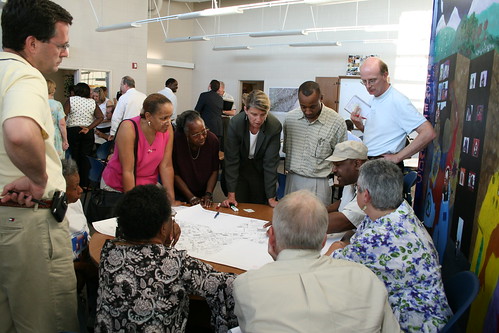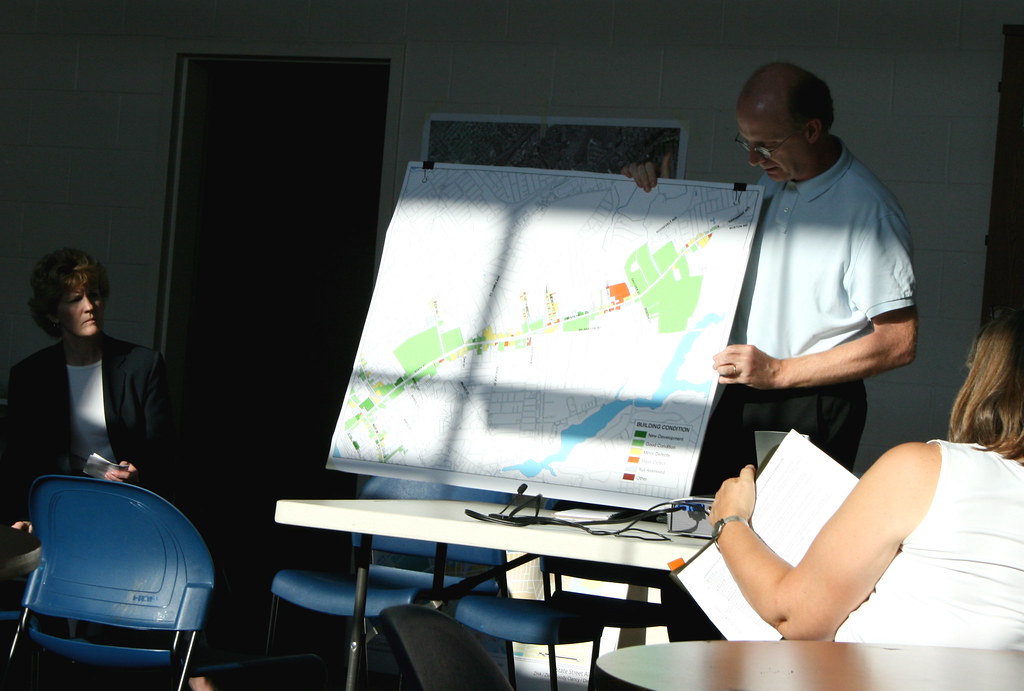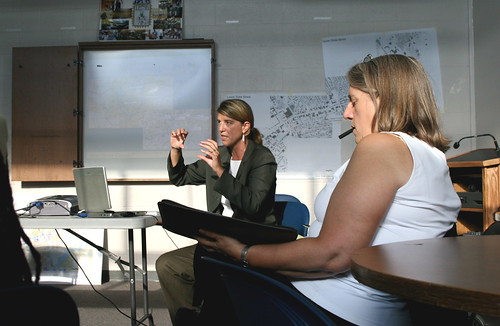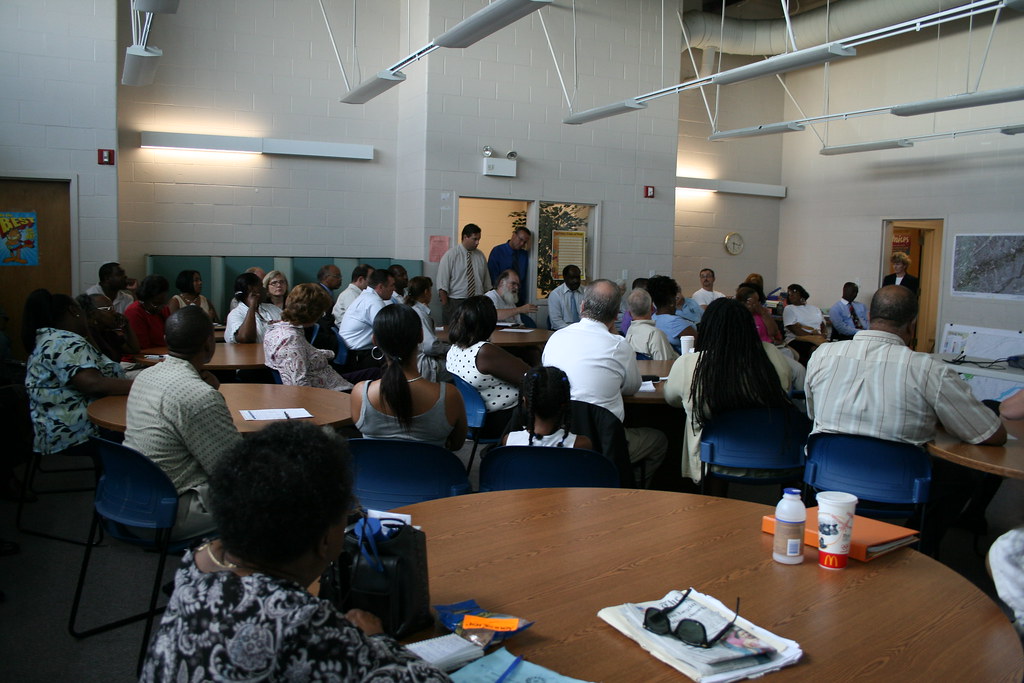 A team of consultants headed by Maryland-based ZHA, Inc. visited Springfield’s Dunbar Community Center on Oak Street in mid-August to make a public presentation.
A team of consultants headed by Maryland-based ZHA, Inc. visited Springfield’s Dunbar Community Center on Oak Street in mid-August to make a public presentation.
The purpose was to share initial findings for a study underway, funded by the State Street Alliance, examining retail and housing market opportunities along the city’s State Street corridor.
Periodically hastening through large amounts of data, during a PowerPoint presentation that could barely be viewed because of direct sunlight streaming into the room through high windows lacking blinds, the consultants appeared less concerned with processing attendees’ various and sometimes forcefully-raised, wide-ranging concerns than they were with simply getting input on locating possible sites for both a new 60,000 square-foot supermarket, as well as some new housing aimed at singles, couples and empty-nesters.

At different points during the presentation, listening participants noted with restrained feeling their worries about the city’s crime problem, its large low-income residential population, its skewed participation in planning processes along racial and ethnic lines, its overall reluctance to invest in its own self and “get involved,” and a perceived need for city residents to believe genuinely in Springfield’s positive potential.
After city councilor Bud Williams volubly described city residents’ apparent reluctance to participate wholeheartedly in their city’s goings-on, lead consultant Sarah Woodworth practically begged, “I’m sorry, I don’t mean to interrupt this, but if [consultant Laurie Volk of New Jersey-based Zimmerman/Volk Associates] can just finish the residential side of it, then we’ll be done all of this, and we can break out [into working groups].”
 “I’d really like to be able to hear [from you],” she continued, “get [your ideas] on the maps and hear these comments, if that would be okay. It’s only about ten minutes more,” she added, only to be followed immediately by resident Carol Aranjo’s lengthy comment, which began, “Well, I would like to just say something. You’re here perpetrating, not deliberately, but the same information [about crime problems] that is not true. The ‘perception,’ as you keep saying—if I say it enough, then people start to believe it.” Aranjo appeared to have grown impatient with the euphemism of Springfield’s crime perception challenges, and was of the opinion that crime is not as bad as it is made to be; others at the meeting blatantly disagreed.
“I’d really like to be able to hear [from you],” she continued, “get [your ideas] on the maps and hear these comments, if that would be okay. It’s only about ten minutes more,” she added, only to be followed immediately by resident Carol Aranjo’s lengthy comment, which began, “Well, I would like to just say something. You’re here perpetrating, not deliberately, but the same information [about crime problems] that is not true. The ‘perception,’ as you keep saying—if I say it enough, then people start to believe it.” Aranjo appeared to have grown impatient with the euphemism of Springfield’s crime perception challenges, and was of the opinion that crime is not as bad as it is made to be; others at the meeting blatantly disagreed.
In attempting to acknowledge participants’ repeated concerns about safety, and differing ideas about whether Springfield’s is a perception problem or a real, pressing need, Woodworth said, “I wasn’t saying that this safety issue is [merely] a perception.”
“But I think,” she continued, “the development opportunities and investment potential in Springfield [are] much greater than this market understands. It’s a very large market with a lot of expenditure potential that is not being capitalized upon.”

Indeed, that was the consultants’ overriding point: even a largely low-income population has strong purchasing power, and there is a lot that isn’t being done along the corridor. What little is being done for retail and housing isn’t necessarily well-executed.
The consultants did not wish to get into a discussion about urban crime perception, how to establish living wages for low-income residents, or whether racial and ethnic harmony is being adequately addressed in the city’s planning process. They had data; they were in a position to share it; they wanted site recommendations.
 While Volk (pictured at left, talking with City Councilor Bud Williams) offered a repeatedly-interrupted presentation about residential market potential, one meeting attendee blurted out a comment about how any new housing project (”No, a development,” Volk corrected) will “be like we have already, just fancier”—for example, construction of loft apartments, which Volk described as appealing to young people. To the remark, Volk replied selectively, “If I can get through this [presentation], then you guys get to come up and actually point out sites that you think would work for places [where] we could do housing and retail.”
While Volk (pictured at left, talking with City Councilor Bud Williams) offered a repeatedly-interrupted presentation about residential market potential, one meeting attendee blurted out a comment about how any new housing project (”No, a development,” Volk corrected) will “be like we have already, just fancier”—for example, construction of loft apartments, which Volk described as appealing to young people. To the remark, Volk replied selectively, “If I can get through this [presentation], then you guys get to come up and actually point out sites that you think would work for places [where] we could do housing and retail.”
But pointing out sites—if the intermittently cross reactions of meeting attendees during the general presentation was any indication—seemed to be among the last thing on anyone’s mind. There were questions, and a desire to understand and shape a much bigger picture than that which the consultants were being paid to portray.
Instead, various seemingly tangential comments during the meeting ended up sounding like a performance of sorts, while attendees voiced a number of important concerns in apparently the wrong context, perhaps even more for the benefit of each other than for the consultants. If not to confirm one another’s ideas, some of the comments raised were possibly evidence that stakeholders don’t know where to go with such concerns or ideas, and the community may lack focus and validation.
What other opportunities are there, after all, for residents to come together and publicly express their thoughts and concerns about development and potential along the city’s spinal column? How many of them are possibly holding on too tight to old ideas that will no longer apply to the circumstances?
What the city may benefit from most of all is an infusion of fresh thought and perspective, balanced with the best efforts possible toward fact-gathering and the tempered wisdom of experience.
The two working groups that formed toward the end of the meeting proceeded with quiet energy, with much resulting murmuring, idea-exchanging and scribbling on maps for the consultants to take home. Click here to read an edited transcript of the proceedings, with pictures.


